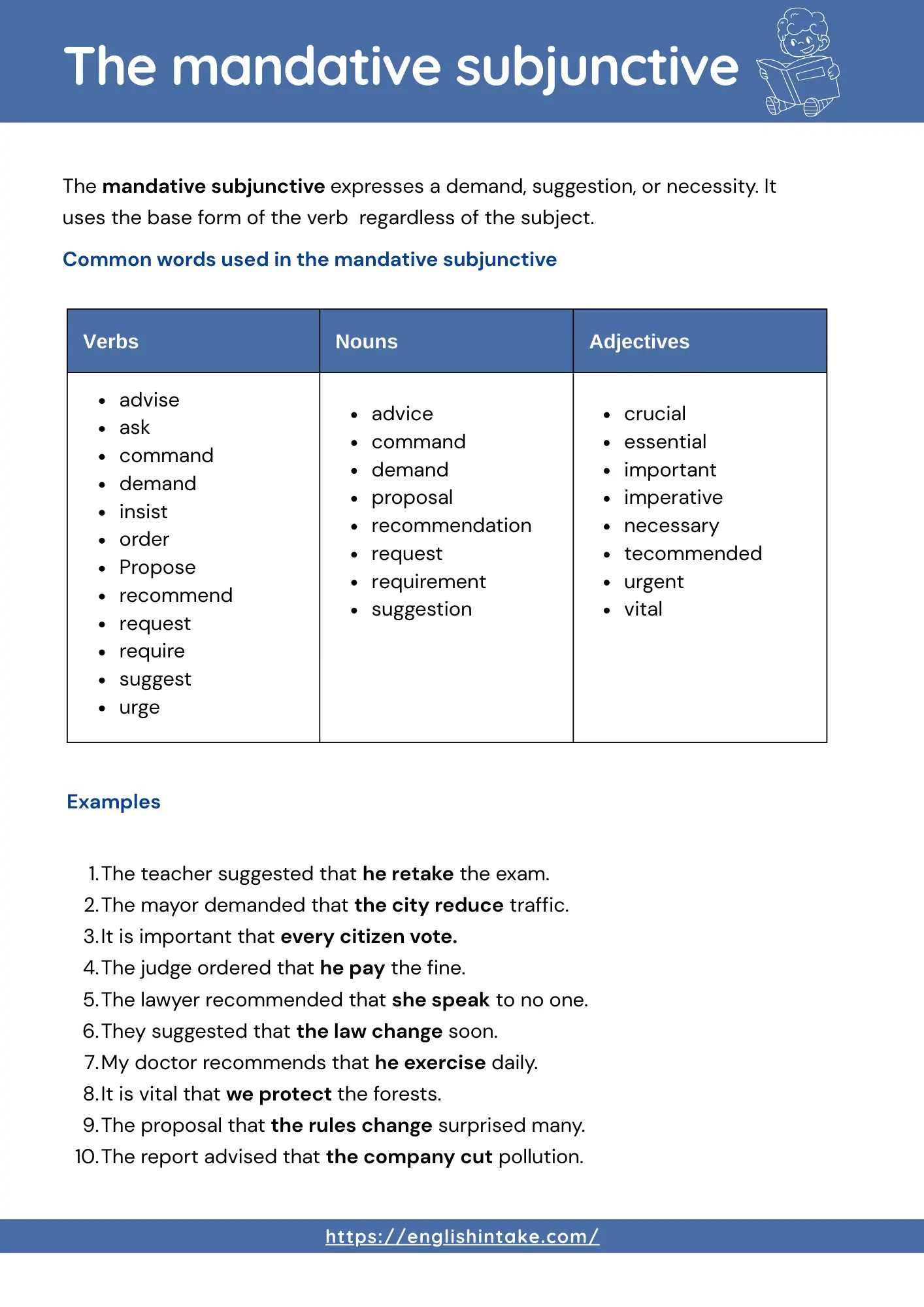1. What is the mandative subjunctive?
The mandative subjunctive expresses demands, suggestions, recommendations, or requirements. It is used with verbs, nouns, or adjectives that imply necessity or obligation. The mandative mood uses the base form of the verb (e.g., be, go, have) regardless of the subject.

Examples:
It is essential that he be on time.
She suggested that they leave early.
2. When to use the mandative subjunctive?
The mandative subjunctive is used in formal or written English, especially in contexts involving:
1. Demands: The boss demanded that she finish the report.
2. Suggestions: I suggest that he apply for the job.
3. Recommendations: The committee recommended that the policy be revised.
4. Requirements: It is necessary that all students attend the meeting.
3. Structure of the mandative subjunctive
The mandative subjunctive uses the structure below:
Trigger word + that + Subject + Base verb
We always use the base form of the verb even if the sentence refers to the past. To make the mandative sentence negative, we add not before the verb, without using do as a helping verb.
Examples:
1. She suggested that he go to the meeting.
2. It is important that they be prepared.
4. Identification?
Here are some common words that are usually used to introduce the mandative subjunctive.
demandThe boss demanded that she finish the report.
suggestI suggest that he apply for the job.
recommendThe doctor recommended that she rest for a week.
insistShe insisted that they leave early.
requestHe requested that the meeting be postponed.
proposeThey proposed that the plan be revised.
demand (noun)The demand that he resign was met with resistance.
suggestionHer suggestion that we start early was accepted.
recommendationThe recommendation that the policy be changed was approved.
requirementThe requirement that all students attend the lecture was strict.
proposalThe proposal that the budget be increased was debated.
essentialIt is essential that she be on time.
necessaryIt is necessary that they complete the form.
importantIt is important that he understand the rules.
vitalIt is vital that the issue be resolved quickly.
crucialIt is crucial that we act now.
5. The difference to indicative
The mandative subjunctive uses the base form of the verb (e.g., be, go, have) and comes after verbs, nouns, or adjectives that imply necessity or obligation, such as demand, suggest, essential, or recommendation. It is more common in formal writing or speech, especially in American English.
For example, "It is essential that she be on time" uses the subjunctive to convey necessity.
The indicative mood uses standard verb forms that agree with the subject in tense and number, making it more common in informal or spoken English. For instance, "It is essential that she is on time" uses the indicative, which is less formal and more typical in British English.
The mandative subjunctive is more common in American English than in British English. In British English, the indicative mood or modal verbs (e.g., should) are often used instead.
6. Historical development
The mandative subjunctive has undergone significant historical development and exhibits notable dialectal variation across English-speaking regions. Historically, the subjunctive was widely used in Old and Middle English but saw a decline in frequency during the Early Modern English period. However, it experienced a revival in American English during the 19th and 20th centuries, particularly in formal writing, where it remains a common feature.
British English has largely replaced the subjunctive with the indicative mood or modal constructions (e.g., should + base verb). For example, while an American speaker might say, "It is important that she be informed," a British speaker would more likely say, "It is important that she is informed" or "It is important that she should be informed."
